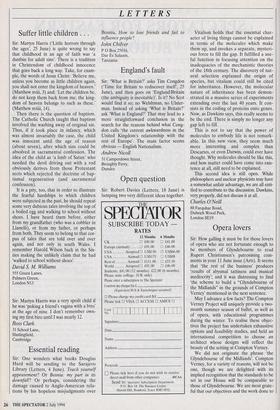So he wore himself out. Towards the end of the
exhibition is a replica of his tomb in the Pugin Chantry Chapel in the church he built himself next to his house at Rams- gate. And really the show should have ended here. The postcript is an anti-climax: some too-familiar pieces which illustrate the tired old line that Pugin's True Princi- ples of Pointed or Christian Architecture 'There should be no features about a build- ing which are not necessary for conve- nience, construction or propriety', etc. underpin progressive furniture design. Of course, as Ruskin's disciple, the architect J.D. Sedding, wrote in 1988, 'We should have had no Morris, no Street, no Burges, no Shaw, no Webb, no Bodley, no Burne- Jones, no Crane, but for Pugin.' While, as David Watkin argued in Morality and Architecture, Pugin's insistence on the exclusive claims of Gothic certainly led straight to the moral arrogance of the Modern Movement; but the idea that chairs by Alvar Aalto or Frank Lloyd Wright have any meaningful connection with Pugin's passion for the Middle Ages seems to me far-fetched.
The contradictions in Pugin's theories and influence are pointed out by Andrew Saint in his essay in the sumptuously illus- trated book, Pugin, edited by the exhibi- tion's organisers, Paul Atterbury and Clive Wainwright (Yale: f45.00 cloth; £19.95 paper). This is a necessary volume. The sadness, however, is that there is no proper catalogue to the many and special objects on display — many for the first time. Rumour has it that the Director of the V&A cares little for shows which merely seek to broaden horizons, disseminate knowledge and encourage scholarship, so that this wonderful exhibition would not have happened without the generous finan- cial support of Pearson's. That this tribute to a supremely gifted and influential English designer ends with a large shop,


























































 Previous page
Previous page